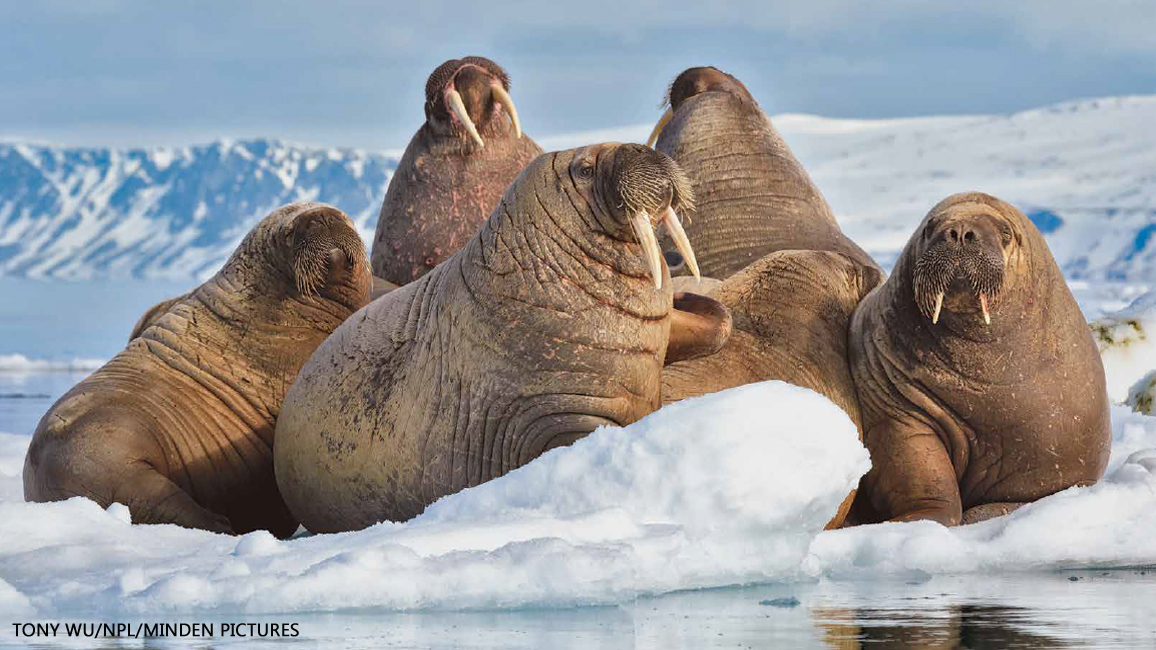
Husky Tuskies
By Kathy KrankingWalruses are super at surviving in their cold, watery world.

They’re big. They’re bulky. They can weigh a ton and a half and be up to 12 feet long. You might say walruses are the “incredible hulks” of the Arctic! But despite their size, walruses don’t mind being crowded together—or even piling on top of each other! Whether they’re floating on ice as these are, “hauled out” on a beach (photo in circle), or swimming underwater, walruses have what it takes to survive when temperatures plunge.

Super Skin
A walrus is a big bundle of blubber wrapped in tough, wrinkly skin! The blubber is a thick layer of fat that keeps the walrus warm. This “built-in blanket” can be up to six inches thick. The walrus’s super-thick skin protects the animal during tussles with other walruses or attacks from predators.
Grippy Flippers
A walrus uses its flippers to get around. It has two triangular hind flippers like this one and two square front flippers. The flippers have small claws. Rough skin on the bottoms of the flippers gives the walrus a good grip when it’s on land or ice.
A walrus uses its powerful hind flippers to push itself along when swimming. It holds the front flippers at its side or uses them to steer. On land, a walrus crawls along using its front flippers and dragging its hind flippers behind it.
Tusky Tools
Look at the awesome tusks on this snoozing walrus! Tusks are actually super-long teeth growing from a walrus’s upper jaw. Both males and females have them, but the males’ tusks are bigger, sometimes growing as long as yardsticks! Walruses “haul out” of the water onto land or ice by pulling themselves up with their tusks and front flippers. Tusks are also great tools for breaking breathing holes in the ice. Males use them as weapons during tussles over space on the ice or the beach. And tired walruses in the water may hook their tusks over the edge of floating ice to anchor themselves while they nap!
Hard-Working Whiskers
Walruses sure are whiskery! A walrus’s “mustache” is made up of more than 400 bristly whiskers. The whiskers are as sensitive as fingers, and the walrus uses them to find food such as snails, worms, or clams—its favorite. To hunt, it swims along the sea bottom, feeling with its whiskers. When it finds a clam, it uses its mouth to suck the animal right out of its shell. A walrus can eat as many as 6,000 clams in a day!

Face to Face
A hungry polar bear might be thinking about attacking one of these walruses. But it probably wouldn’t stand much of a chance. Walruses have size and sharp tusks in their favor. Also, their tough skin protects them pretty well against a bear’s claws and teeth. Polar bears and orcas are the only natural predators of walruses. But they will mostly attack only young ones.
Rough and Tough
Walruses usually love being together. They swim, hunt for food, and rest in groups. But sometimes they squabble—whether trying to reach females to mate or just over space to lie down and rest. Many walruses have scars on their necks and shoulders from being scratched or jabbed with tusks. As you can see above, sometimes tusks get broken off.
Big Baby
A walrus mom usually gives birth to one baby, or calf, at a time. A newborn calf may be almost as long as you are tall! The baby nurses from its mom, drinking her rich milk. Mom and Baby stick close together, and a mother walrus is very protective of her calf. She often holds it with her front flippers, as this one is doing here. A calf sometimes rides piggyback on its mother in the water. It will stay with its mom for two or more years.
In the Pink
Walruses love to sunbathe. And after they have been in the sun for a while, they begin to look pink. They aren’t getting sunburned, though. As they warm up, tiny blood vessels just under their skin open wider. This gives the skin its pinkish look. The open blood vessels let the walruses release body heat, which cools them off. When the walruses are swimming in icy water, the blood vessels close up so the walruses can hold all that warmth inside.
















